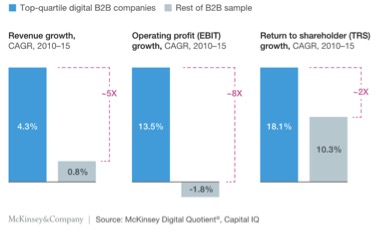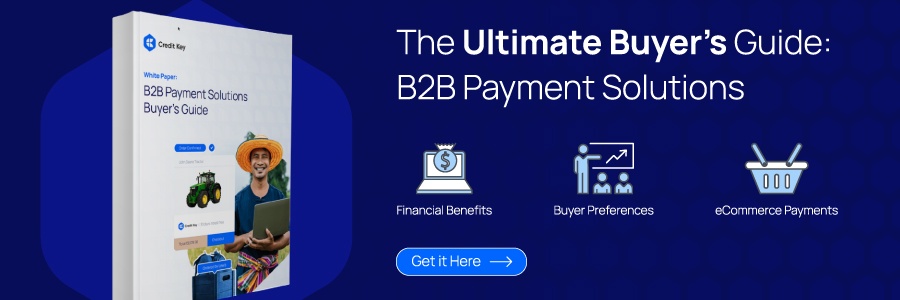It’s no secret that digital technology has transformed how we view and interact with the world, especially with how we shop. As consumers, we’ve become accustomed to going online to find the products we need—books, clothing, cookware, laundry detergent, electronics, etc. We’ve also become used to the convenience that online shopping offers; services like Amazon Prime Now allows us to order a huge variety of products and have them delivered in only two hours.
Despite the changes in consumer buying experiences, the experience of buying from a B2B merchant has by and large not changed in the last 25+ years. In fact, according to market research firm McKinsey, the average B2B company scores less than 50 percent on consumer-experience index ratings, lagging far behind average B2C companies that score between 65 and 85 percent. B2B companies have mostly lagged behind the adoption of digital technologies that customers have come to expect. For example, a different McKinsey survey found that fewer than 10 percent of B2B companies have a mobile strategy, despite the fact that smart phone penetration has surpassed 80 percent.
The result is that B2B companies that put off adopting digital technologies are putting their long-term growth and financial performance at risk.

The message is clear: Adopt new digital strategies or risk underperforming competitors.
Adoption, of course, isn’t easy. And in B2B, it can be downright complicated, to the point where firms face a considerable amount of organizational inertia. But there are two key areas where your company can start in order to break free of inertia and start being more customer-focused.
Listen to the customers
So what is it that B2B buyers are saying that firms need to pay closer attention to? Well, to find out, it’s essential to truly listen to your customers. That can be anything from talking to your top clients one-on-one and asking them what’s working to a more formal customer satisfaction survey.
What should you be asking them? Here are some areas to probe:
● Do you use your mobile device to make B2B purchases?
● Is it easy to find what you’re looking for on our website?
● Do you find enough selection on our website?
● Do you find the checkout process easy?
● Are you satisfied with the buying experience on our website?
You may also want to ask customers to rank the features they’d like to see on your site (either that exist already or are planned for the future):
● Preferred channels for buying
● Product sorting/filtering
● Site search
● Flexible delivery options
● Flexible payment options
Listen to the data
While the first step should be your customers, it’s also essential to understand them through the data they generate. Today, companies have access to enormous amounts of data—some of which they own and some of which are owned by third parties. Start by focusing on what data your company owns and what insights you can draw from it.
What kind of data are we talking about? Basic website visitor data is a good start—visits, time on site, page views, etc. But also look at things like shopping cart abandonment and average order sizes. Most importantly, try to connect data from your e-commerce platform to other data sources such as digital marketing. For example, are you tracking the connection between email marketing metrics and purchasing behaviors? Are you tracking the connection between social media engagement and sales calls? There are a wide variety of metrics out there that, if looked at together, can yield some powerful insights to help you better meet customer needs.
Putting it all together
The reason why it’s important to look at both the data and what your customers are saying is because they may tell different stories. Your customers may say, “Everything’s fine,” but your shopping cart abandon rate is through the roof (a sign that everything is, in fact, not fine). By gaining a more complete understand of your customer’s needs, and comparing that with their actual online behavior, you’ll be able to identify the best path forward to becoming more customer-focused. And once you have an idea of what your customers really want and need, it’s far easier to identify digital solutions that will help you grow ROI.
To find out how Credit Key connects the dots between flexible payment solutions and customer satisfaction (not to mention higher revenues), contact us. We’re happy to show you how to unlock a better B2B customer experience.
